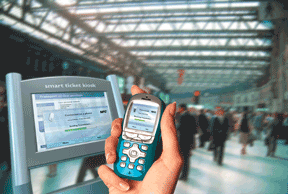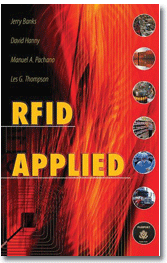The best of both worlds, Contactless convergence with mobile wireless
08 October, 2005
category: Contactless, Financial, Library, NFC
 By Heather Klein and John O’Malley, Giesecke & Devrient
By Heather Klein and John O’Malley, Giesecke & Devrient
Imagine a scenario where Joe Smith is leaving his house in the morning to head to work, grabbing his mobile phone as he heads out the door. Joe starts down the street, calling the office to check messages, and ducks into the local coffee shop. While still on his voice call, Joe pays for his morning java by waving his phone over the contactless point of service reader at the counter. The funds are deducted from the electronic purse stored on his (U)SIM card in his mobile phone. Moments later, Joe receives a text message indicating a low balance on his e-purse and reminding him to replenish his account. Joe searches the menu on his phone and, directly from his handset, checks the balance in his bank account and transfers funds to replenish his e-purse. He also quickly checks the train schedule and his stock portfolio from his handset’s menu.
Reaching the metro station, Joe waves his phone by the turnstile, identifying the station that he’s entered and confirming the presence of the electronic ticket stored in his (U)SIM. Joe receives another text message with the morning news headlines. He activates the interesting ones and the contents of the articles appear on his screen. A few stops later, Joe exits the metro and again passes his mobile phone by the turnstile. This time, the e-ticket fare for the metro ride he just took is automatically deducted from the (U)SIM and an update message is sent to the Transit Authority’s database to calculate his monthly ridership credits.
 Arriving at the office, Joe waves his phone near the reader on the door, releasing the lock and allowing his entry. At his desk, Joe places his phone on the reader next to his PC, which initiates his secure computer login. When Joe leaves, he removes his phone, automatically locking his computer and allowing him to continue through his day, conducting business, making payments, and receiving secure access via his mobile at every step of the way.
Arriving at the office, Joe waves his phone near the reader on the door, releasing the lock and allowing his entry. At his desk, Joe places his phone on the reader next to his PC, which initiates his secure computer login. When Joe leaves, he removes his phone, automatically locking his computer and allowing him to continue through his day, conducting business, making payments, and receiving secure access via his mobile at every step of the way.
Sound futuristic? All these mobile applications – and many others – are currently available and in use in the marketplace today, but we’re just scratching the surface of this technology convergence. In our wireless world, the consumer expects mobility and convenient access to a host of services, both personal and for the enterprise. Helping to meet this consumer demand is the convergence of technology, namely contactless and mobile.
The growth and penetration in contactless card technology, particularly in the last few years, is evident. This includes the proliferation of touch-and-go fare collection for parking and transit in major cities, the common use of ID and physical/logical access cards in the enterprise space, the movement towards electronic passports, and the emergence of contactless payment.
If we tie in the highest penetrated smart card application, namely mobile telephony, we find an excellent match of two well accepted technologies. How these technologies converge in practice leads to different challenges, opportunities and business cases for the stakeholders – the issuers, the manufacturers, and the consumers.
The Vision
Going forth, the vision for the consumer takes the current voice and data communication channels and adds a contactless communication channel, which transforms today’s mobile phones into a multipurpose terminal, lifestyle tool and personal security device. This transformation can be accomplished in a variety of ways. The first is the introduction of a dual-interface UICC (Universal Integrated Circuit Card), combining (U)SIM applications for 2G or 3G networks with contactless capability. The second is the integration of contactless technology, Near Field Communications (NFC), into the handset itself. The third is the introduction of a removable multi-media card (MMC) with integrated security and contactless technology.
The Perfect Match
There is a high degree of technology convergence and application cross-over between mobile and contactless technologies. Mobile telephony is characterized by high penetration and the demand of access and applications by the user on their “personal device.” Convenience and simplicity are key attributes of the contactless and NFC space. The market is looking to exploit these contactless benefits with the “connectivity” offered by GSM telephony in order to marry local transaction services with remote transaction services.
This perfect technology match will likely occur in the marketplace in a two phased approach. The first phase is where the phone becomes a contactless card or token – the dual interface (U)SIM offering applications convergence in the areas of touch-and-go fare collection, ticket purchase and both physical and logical access in the enterprise.
The second phase brings the bi-directional NFC capability to the phone, where it acts as both contactless card and card reader to facilitate credit card or ID card access, converging with the ubiquitous connectivity of GSM.
There are three practical implementation scenarios to realize this convergence in mobile devices. The first involves the introduction of a dual interface (U)SIM card. The unused electrical contacts on the security module provide the electrical interface to a coil antenna to allow contactless communications with an external reader. Contactless applications reside on the card, which is issued by the wireless operator.
In a similar implementation, a secure MMC card incorporating a smart card controller device offers similar utility with additional memory and the option of issuance by a third party. Both of these options provide the benefits of high security, low latency, ease of personalization and portability. They do, however, introduce challenges in antenna integration with the mobile device.
Another implementation scenario involves integrating the contactless interface and security controller directly into the handset. Without any (U)SIM involvement, the separate controller handles security and application storage, but personalization is certainly a concern in the commercial manufacturing process. This clearly takes advantage of the growing consumer demand for phone based applications by integrating NFC technology where the phone becomes both the contactless card and reader. This solution requires changes to the phone interface, but offers good antenna integration as it is built into the phone at manufacturing. Prioritization by the mobile phone operating system may introduce slight latencies in the contactless application and the “power-on” requirement for controller operation may have utilization impacts. A variant on this implementation keeps the integrated antenna in the mobile device, but ties in the (U)SIM as a security controller. This inherently simplifies the personalization process. This option also allows for contactless operation even when the phone is turned off.
The reality is that all scenarios exist, and will be dictated by the regional markets, the local application demands and the usage models. There are already two successful implementations of differing scenarios in the market. The FeliCa project in Japan uses a NFC chip which is soldered into the phone for transportation fare collection and payment transactions. Subsequently, there was a migration to a token with the Moneta project in Korea, where they introduced a separate card into the handset for credit card and e-Cash transactions.
The Antenna Challenge
One major challenge to the full exploitation of contactless and mobile convergence is the integration of the handset antenna. Several options have been introduced to solve this hurdle. One option integrates the antenna directly into the handset, establishing a connection to the contactless (U)SIM using the two unused electrical contacts on the card. This is a dedicated design which must be integrated into each handset.
Another mass-market option upgrades the handset with an antenna accessory. The antenna accessory attaches to handset cover and establishes a connection to the contactless (U)SIM. One benefit to this option is that legacy handsets in the field are easily upgraded to include the new feature. The third option makes the antenna an integral part of the (U)SIM substrate also allowing legacy handsets to be easily upgraded.
The Marriage
The merging of contactless and mobile technology directly addresses the ever-expanding demands of the consumer for mobile access to a wide range of services. What makes this technology marriage successful are the complimentary attributes that each offers. Paramount amongst these is the tremendous penetration of wireless and its “personal” service attribute, which further fosters consumer adoption.
Contactless technology offers speed and convenience across all types of applications, whether they are payment or transactional in nature or related to proximity access. We are also seeing rapid growth and consumer adoption of proximity applications such as transit fare collection, physical and logical access, and the emergence of contactless payment with programs such as MasterCard’s PayPass and American Express’ ExpressPay.
Both mobile and contactless technologies are prevalent in the marketplace and adopted by the end user which is key to the commercial success of any technology when considering mass market release. The marriage of these two will only further the widespread use of mobile applications based on smart card technology.
Editor’s note:
Early this year, I saw John O’Malley give an impressive presentation on this topic and asked if he would submit an article to ContactlessNews based on the presentation. I would like to thank Heather Klein, Manager Marketing Communications, and John O’Malley, VP Telecommunications, Giesecke & Devrient, for developing this piece for our readers.
Explore more developments dealing with the implementation of Near Field Communications, a short-range wireless technology that promises to revolutionize contactless identification, payment, access, and more. Click to visit NFCNews.




